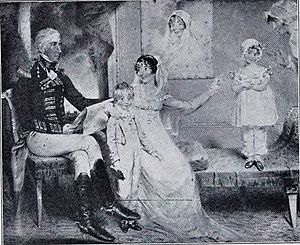Sir George Nugent, 1st Baronet facts for kids
Quick facts for kids
Sir George Nugent
|
|
|---|---|
 |
|
| Member of Parliament for Buckingham | |
| In office 1818–1832 Serving with William Fremantle, Sir Thomas Fremantle, 1st Bt
|
|
| Preceded by | William Fremantle James Hamilton Stanhope |
| Succeeded by | Sir Thomas Fremantle, 1st Bt Sir Harry Verney |
| Commander-in-Chief, India | |
| In office 1811–1813 |
|
| Preceded by | Forbes Champagné |
| Succeeded by | The Earl of Moira |
| Governor of Jamaica | |
| In office 1801–1805 |
|
| Preceded by | The Earl of Balcarres |
| Succeeded by | Sir Eyre Coote |
| Personal details | |
| Born | 10 June 1757 |
| Died | 11 March 1849 (aged 91) Westhorpe House, Buckinghamshire |
| Spouses |
Maria Skinner
(m. 1797; |
| Relations | Thomas Fremantle, 2nd Baron Cottesloe (grandson) |
| Children | 5 |
| Parents | Hon. Edmund Nugent Ms. Fennings |
| Education | Charterhouse School |
| Alma mater | Royal Military Academy, Woolwich |
| Awards | Knight Grand Cross of the Order of the Bath |
| Military service | |
| Allegiance | |
| Branch/service | |
| Rank | Field Marshal |
| Commands | 97th Regiment of Foot 13th Regiment of Foot 4th Royal Irish Dragoon Guards Buckinghamshire Volunteers Western District Kent District Commander-in-Chief, India |
| Battles/wars | American Revolutionary War French Revolutionary Wars |
Sir George Nugent, 1st Baronet (born June 10, 1757 – died March 11, 1849) was an important British Army officer. He served in many different places and roles throughout his long career. He started as a young officer in the American Revolutionary War. Later, he fought in Europe and helped keep peace in Ireland during a rebellion. Sir George also served as the Governor of Jamaica and was the top military commander in India.
Contents
Early Life and Education
Sir George Nugent was born in 1757. His father was Lieutenant Colonel Edmund Nugent. George had a half-brother, Charles Edmund Nugent, who became an admiral.
He went to Charterhouse School and then to the Royal Military Academy, Woolwich. This academy trained him to become an officer in the army.
Military Career Highlights
Sir George Nugent began his military journey as an ensign (a junior officer) in 1773. He was first sent to Gibraltar. Later, he moved to New York and became a lieutenant in 1777. He fought in important battles during the American Revolutionary War. These included the Battle of Forts Clinton and Montgomery. He continued to rise through the ranks, becoming a captain in 1778 and a major in 1782.
Service in Europe and Ireland
In 1783, George Nugent was promoted to lieutenant colonel. He returned to England and commanded the 13th Regiment of Foot. He also worked as an aide-de-camp (a personal assistant) for his brother-in-law, the Marquess of Buckingham, who was a high-ranking official in Ireland.
After his time in Ireland, Nugent commanded the 4th Royal Irish Dragoon Guards. In 1790, he became a Member of Parliament for Buckingham. He then joined the Coldstream Guards. He fought in the Flanders Campaign in Europe, taking part in battles like the Siege of Valenciennes in 1793.
The army later asked him to help create the 85th Buckinghamshire Volunteers. He led this regiment in battles near the Waal river. He was promoted to major general in 1796. In 1798, he became the commander of the northern district of Ireland. He played a key role in calming the people of Belfast during the Irish Rebellion. He also became the Adjutant-General (a senior staff officer) in Ireland.
Important Leadership Roles
In 1801, Sir George Nugent became the Governor of Jamaica. While there, he helped make the forts stronger, especially Fort Nugent, which protected Kingston Harbour. He was promoted to lieutenant general in 1803.
After returning to England in 1806, he became the commander of the Western District. He was also elected as a Member of Parliament for Aylesbury. In 1806, he was given the special title of baronet. He bought Westhorpe House in Buckinghamshire in 1808.
In 1811, Nugent became the Commander-in-Chief, India. This was a very important role, making him the top military leader in India. He was recognized for his service and became a Knight of the Order of the Bath in 1813. He was promoted to full general in the same year.
Sir George Nugent retired from Parliament in 1832. He continued to be honored for his long service. In 1846, he reached the highest rank in the British Army: field marshal.
Family Life

Sir George Nugent married Maria Skinner in 1797 in Belfast. Maria was from a well-known family in America. They had five children together: three sons and two daughters.
Their children included:
- Sir George Edmund Nugent, who became the 2nd Baronet.
- Louisa Elizabeth Nugent, who married Thomas Fremantle, 1st Baron Cottesloe.
- Charles Edmund Nugent.
- Maria Amelia Nugent.
George and Maria Nugent were close friends with his aunt and uncle, Lord and Lady Buckingham.
Lady Nugent wrote a journal about her experiences while living in Jamaica. Sir George Nugent passed away at Westhorpe House in 1849. He was buried in Little Marlow.
Images for kids



